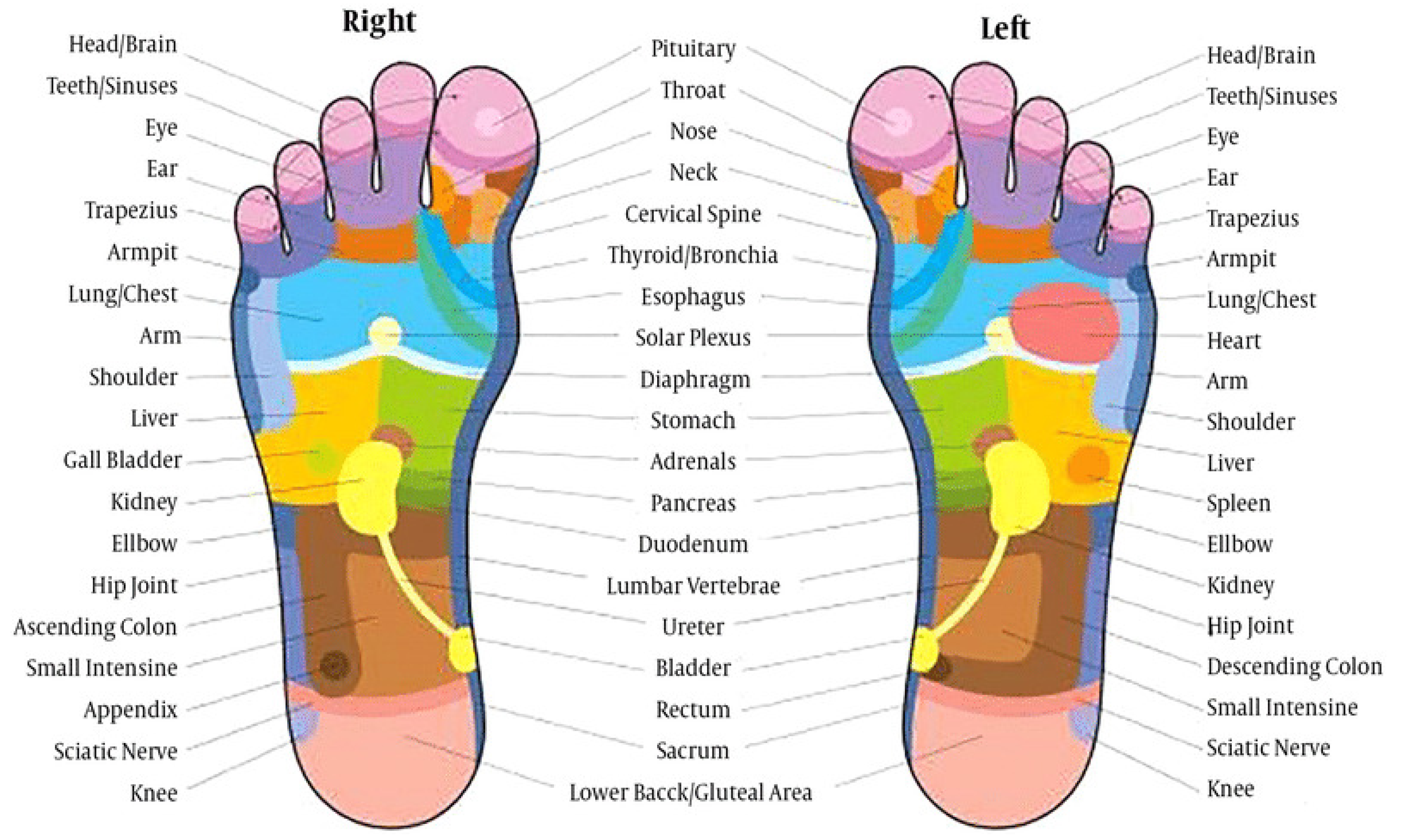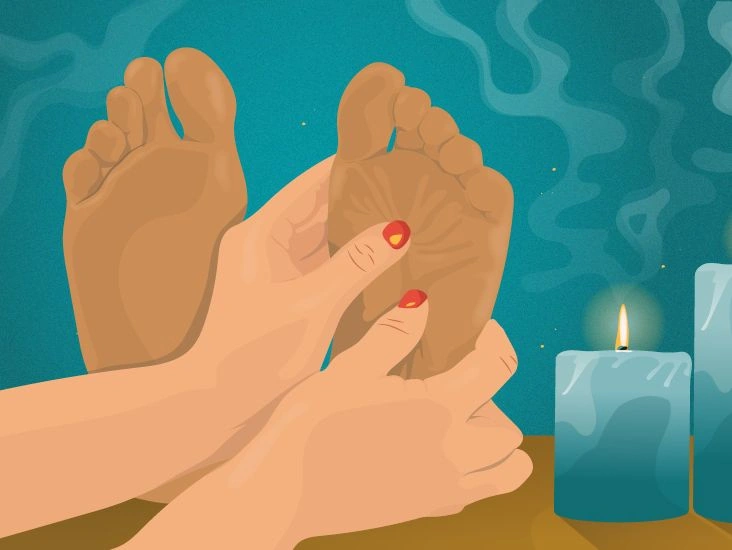Applying acupressure to the feet can encourage relaxation and help relieve stress, among other potential advantages.
Foot reflexology is a therapeutic practice with roots stretching back centuries. It centers on pressing specific spots on the soles of the feet.
In traditional Chinese medicine (TCM), these zones are thought to correspond to various parts of the body. Practitioners claim this can lead to several benefits, such as stress reduction, improved digestion, and better sleep.

What is reflexology?
“Reflexology is typically described as a holistic technique performed on the feet,” says Brian Goodwin, aesthetician, herbalist, and international instructor at Éminence Organic Skin Care. “The idea is that meridian points on the feet align with different organs in the body.”
Los Angeles–based chiropractor Dustin Martinez notes that reflexology can enhance quality of life in multiple ways.
That includes lowering stress and bringing balance to the body, as well as to energy and the mind.
“Reflexology is an ancient form of medicine — it’s been practiced for ages,” he says. “Its origins can be traced back to around 2330 B.C.”
Martinez adds that the term reflexology was adopted in the United States in the early 20th century.
Foot reflexology benefits
Foot reflexology might assist with:
- stress relief and relaxation
- pain control
- eyestrain
- enhanced sleep
Stress and relaxation
A 2022 review reported that a primary benefit linked to reflexology is stress reduction and overall relaxation, achieved by applying pressure to particular spots on the feet.
“Relaxation is likely the most significant benefit [of foot reflexology],” says Martinez. “Reflexology can boost circulation throughout the body, which aids in lowering stress and anxiety and can reduce blood pressure. When stress and anxiety decrease, relaxation follows more easily.”
Pain management
Possibly connected to its calming effects, foot reflexology might also be useful for managing both short-term and long-term pain.
The same 2022 review found it could help lessen various types of pain, including:
- headache-related pain
- back pain
- joint pain
- pain linked to cancer symptoms
The technique may also ease postoperative pain. A 2020 study discovered that foot reflexology notably decreased pain following kidney transplant surgery compared with a control group.
Eyestrain
“Reflexology can help alleviate some of the strain we place on our eyes through daily activities,” says Martinez. “Targeting these pressure points can relax tight muscles caused by prolonged screen time.”
Improved sleep
Given reflexology’s potential to promote relaxation and lower stress, it’s unsurprising that some people report it helps improve sleep quality.
“Because reflexology moves energy and enhances circulation, it’s common to experience a restful night’s sleep after a session,” Martinez explains.
In the aforementioned 2020 study on post-kidney transplant patients, those who received foot reflexology showed significantly better sleep quality.
Does reflexology work?
Reflexology may serve as a supportive therapy used alongside conventional treatments — often called a complementary approach.
It’s worth noting that, despite reflexology’s long history across many cultures, robust scientific proof for its effectiveness is limited.
Claire Barnwell, a member of The Association of Reflexologists and owner of Feetology, says, “Some positive research exists on reflexology; however, there isn’t yet a large enough body of evidence to make definitive clinical claims.”
Barnwell adds that “what reflexology undeniably offers is a dedicated period for relaxation during which the client receives one-to-one attention and comforting touch in a compassionate, attentive setting.”
At minimum, foot reflexology can be a calming, massage-like way to relax and give focused care to your feet. Further research is needed to determine whether it delivers specific health outcomes.
Reflexology side effects and contraindications
Barnwell observes that most people feel a sense of well-being and relaxation after a reflexology session. However, some side effects may occur, including:
- fatigue
- nausea
- tearfulness or crying
- dizziness
- strong emotional releases
“These effects are usually temporary, and reflexologists view them as part of the healing response,” Barnwell says.
Reflexology is not appropriate for everyone. For individuals with particular health issues, it may pose risks, such as exacerbating:
- circulatory disorders
- gout
- a history of blood clots
- certain foot injuries like sprains, strains, or stress fractures
- painful skin conditions such as blisters or severe eczema or psoriasis
- contagious skin conditions like scabies, chickenpox, or athlete’s foot
- some diabetic complications, including non-healing ulcers or peripheral neuropathy
Consulting a healthcare professional before beginning a new therapy can help determine whether reflexology is suitable for you.
Reflexology is not advised for those with gout, a history of blood clots, or circulatory problems.
If you are pregnant, consult your physician before trying reflexology.
Massage vs. reflexology: What’s the difference?
Although both massage and foot reflexology are known for promoting relaxation, they serve different purposes.
“Foot reflexology is a therapeutic technique that uses sustained pressure rather than sweeping strokes, as in a traditional massage,” explains Martinez. “It applies precise pressure to particular reflex points and maintains that pressure until a release is felt.”
A standard massage may be better suited for overall relaxation and easing muscle soreness, whereas reflexology aims to address specific concerns by focusing on targeted points on the feet.
How long before you start seeing benefits?
Martinez says most clients notice effects after their first reflexology session.
“Each person is unique and heals on their own timeline,” Martinez notes. “Generally, reflexology works best as a complement to the body’s natural healing processes.”
While benefits can sometimes be felt after a single session, continuing reflexology alongside other clinician-recommended treatments is advised for optimal outcomes.
Takeaway
Though reflexology may not be established as a medical cure for specific conditions, it has been used for centuries to address a range of complaints.
Foot reflexology can be a helpful complementary therapy, but strong scientific backing is still limited.
Always consult a healthcare provider before trying reflexology. Individuals with circulatory issues, gout, or a history of blood clots should avoid it.


















Leave a Reply
You must be logged in to post a comment.